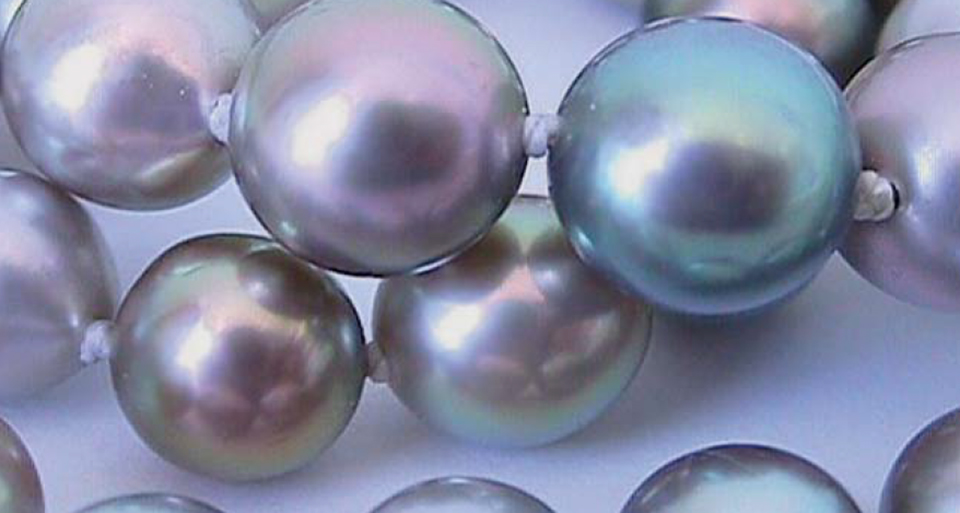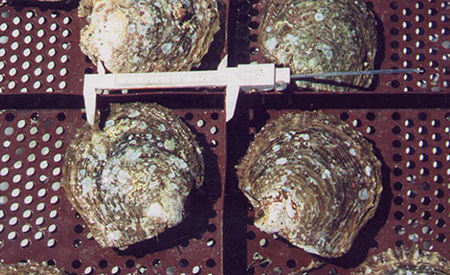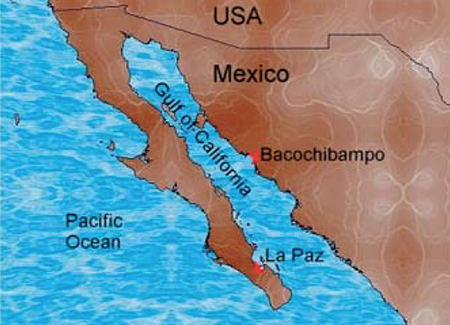Potential for farms along the Gulf of California, Mexican Pacific coast

Pearl culture is one of the more valuable aquaculture industries in the world, with an estimated retail value of around U.S. $5 billion per year. Most of the world’s marine pearls are produced by western Pacific pearl oysters (Pinctada maxima, silver or gold pearls), P. margaritifera (black pearls) and P. fucata (white pearls). Japan, Australia and French Polynesia are the main pearl-producing countries.
Scientific research has focused mainly on the three pearl oyster species above. The past 15 years have provided the most significant advances in hatchery spat production, genetic manipulation and pre- and postoperative grafting treatments.
Pearl oyster production in Mexico

Mexico was a pioneer in culturing pearl oysters. Before the end of the 19thcentury, Compañia Criadora de Concha y Perla, a large venture based in La Paz Bay, collected wild pearl oyster spat and grew the oysters to adult stage. Seeding operations were not performed, and only natural pearls and shells were harvested. The company held in culture over 3 million adult pearl oysters. In the early 1900s, the company was destroyed during the Mexican Revolution and never recovered.
Afterwards, pearl oyster fishing fleets increased in numbers. But after an unusually high mortality attributed to such causes as overfishing, El Niño, the closing of the Colorado River as it flowed into the Gulf of California, and even deliberate poisoning, the federal government decreed a total ban on fishing for pearl oysters in 1939. Nowadays, wild populations have still not recovered, and illegal fishing activities remain a problem.
During the 1960s, attempts to establish a pearl farm in La Paz Bay were abandoned when the Mexican government stopped the project due to lack of appropriate legislation and disagreements between the authorities and farm management. This lack of support prevented any further new projects.
At around this time, the pearl industry of French Polynesia began to develop. Forty years later, Tahitian black pearls are well-known, and Mexican pearling is still in its infancy.
Species
Two pearl oyster species, Pinctada mazatlanica and Pteria sterna, are found on the Pacific coast of Mexico and in the Gulf of California. P. mazatlanica are very similar in appearance to the black-lip pearl oyster P. margaritifera. Pt. sterna are smaller than their counterpart, Pt. penguin.
P. mazatlanica show a distinctive metallic-green lip with overtones in blue or pink. Their pearls range in color from white to dark gray with blue and green hues, and can reach 13-15 mm in diameter. Pt. sterna show probably the largest range of nacre colors of any pearl oyster species: pale white, blue, green, purple, pink, gray, and gold. These pearls attain an average diameter of 9 mm. International experts have recognized the quality of the nacre and pearls of these two species of Mexican pearl oysters.
Research

Early studies were focused on reestablishing natural population stocks or creating new populations through the transplanting of oysters to selected places showing low abundance. Success was very limited until the early 1990s, when the basics for repopulation were established.
During the last 10 years, pearl oyster research in Mexico increased significantly in areas such as larval rearing and settlement in the hatchery, wild spat collection, nursery culture techniques, repopulation, reproductive biology, and pearl production of “mabe,” or half pearls and round pearls. Research institutions such as Centro de Investigaciones Biológicas del Noroeste, Instituto Tecnológico y de Estudios Superiores de Monterrey (ITESM), and Universidad Autónoma de Baja California Sur have received national, international, and institutional funds to develop pearl oyster culture technology.
Thanks to these projects, some groups have started producing mabe on a commercial scale, and Mexican pearls are now seen in national and in- ternational markets. Also, repopulated banks of pearl oysters have been successfully maintained in La Paz Bay.
Industry
In 1994, the first cultured half pearls were obtained under experimental and pilot scale, but it was not until 1996 when the first commercial harvest of mabe from Pt. sterna was obtained by ITESM in Bacochibampo Bay, Guaymas. ITESM production is currently around 5,000 mabe and 5,000 round pearls per year. The unique necklace “Isabella,” with 43 round 8.0- to 10.5-mm Mexican pearls, was sold for U.S. $16,000 last year.
During the past several years, small groups have started to collect wild spat to culture Pt. sterna and produce pearls for the local markets. Plans to develop a pearl quality control policy are under way by these groups. People from within each group perform all nuclei grafting operations.
Though hatchery production is a reality today, it is limited to research activities. Enough wild spat, especially of Pt. sterna, can be collected for the current small commercial activities.
Conclusion
The characteristics of Mexican pearls make them a unique product with limited competition in the international market, but great care must be taken when offering them to the world. Strict quality control policies must be implemented to assure a minimum standard of quality and protect consumers as well as the incipient Mexican pearl industry.
Scientific research will continue to focus on reproductive biology as well as pearl production, with a special emphasis on pearl quality. As all the groups have evolved from teaching research institutions, they will also continue scientific research.
There is potential for establishing pearl farms along the Gulf of California and the Mexican Pacific coast. The most likely scenario is that commercial pearl farms will evolve from the small groups currently producing mabe. Other aquaculture groups, such as those working with edible oysters or marine fish, could also start collecting wild pearl oyster spat to diversify their operations and participate in community-based pearl oyster culture programs. The production of round pearls will improve slowly within each group, as the cost to hire expert seeding technicians cannot currently be met.
Another approach to facilitate development of the pearl industry in Mexico would be for state governments to finance local fishing communities to start cooperative pearl farms. Finally, selective breeding and stock enhancement may be the trigger for commercial farms to give more attention to hatchery-produced spat.
(Editor’s Note: This article was originally published in the June 2003 print edition of the Global Aquaculture Advocate.)
Now that you've finished reading the article ...
… we hope you’ll consider supporting our mission to document the evolution of the global aquaculture industry and share our vast network of contributors’ expansive knowledge every week.
By becoming a Global Seafood Alliance member, you’re ensuring that all of the pre-competitive work we do through member benefits, resources and events can continue. Individual membership costs just $50 a year. GSA individual and corporate members receive complimentary access to a series of GOAL virtual events beginning in April. Join now.
Not a GSA member? Join us.
Author
-
Héctor Acosta-Salmón
Pearl Oyster Research Group
School of Marine Biology and Aquaculture
James Cook University
Townsville, Queensland 4811
Australia[117,97,46,117,100,101,46,117,99,106,64,110,111,109,108,97,115,97,116,115,111,99,97,46,114,111,116,99,101,104]
Tagged With
Related Posts

Health & Welfare
Alaska’s purple-hinge rock scallops considered for aquaculture development
Purple-hinge rock scallops are highly prized by local communities and harvested for subsistence in coastal Alaska. To evaluate the suitability of purple-hinge rock scallops for mariculture in Alaska, the authors conducted a four-year grow-out study.

Innovation & Investment
Aquaculture innovators come out of their shells at Fish 2.0
Biannual conference/competition showcased 40 new seafood businesses, or related services, from around the world. Winners were chosen on the strength of the opportunity, meaningful impact and compelling leadership and presentation.

Intelligence
Cooperation across seafood chain can counter mercury reports
Often-referenced but outdated reports have raised concerns over mercury, while in reality, not eating seafood carries greater risk than the minute presence of such chemicals. Cooperation and getting out consistently truthful, positive messages about seafood, the industry will see positive advances.

Intelligence
Hatching a plan for Florida oyster farming
Panacea Oyster Co-op and Pensacola Bay Oyster Co. each aim to open dedicated oyster hatcheries in Florida, which could have a significant impact on the state’s aquaculture industry.


